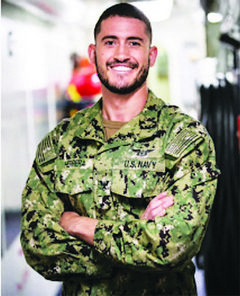Petty Officer Third Class Juan Herrera, a native of Miami, wanted to enlist in the Navy to travel and see the world.

(Photo by Senior Chief Petty Officer Gary Ward)
Now, four years later and half a world away, Herrera serves aboard one of the Navy’s most advanced amphibious ships at Fleet Activities Sasebo, patrolling one of the world’s busiest maritime regions as part of U.S. Seventh Fleet.
“It’s challenging being deployed here, to say the least,” Herrera said. “It’s definitely a mental and physical challenge for me, not letting the day-to-day monotony get the best of me. You have to stay level-headed and remain positive. You have to try to stay focused on your goals.”
Herrera, a 2012 graduate of Ronald Reagan Doral Senior High School, is an aviation boatswain’s mate (handling) aboard the forward-deployed amphibious assault ship USS Wasp in Sasebo, Japan.
“I’m in charge of the launch and recovery of aircraft like the H60 helicopters and the F35 fighter jets,” Herrera said. “We are also trained to put out any aircraft fires on the ship.”
Herrera credits some success in the Navy to lessons learned in Miami.
“I learned a lot of discipline while wrestling in high school,” he said. “The biggest thing I took away was being more goal driven and to do something right the first time. All these lessons have made the Navy easy for me.”
U.S. Seventh Fleet spans more than 124 million square kilometers, stretching from the International Date Line to the India/Pakistan border; and from the Kuril Islands in the north to the Antarctic in the south. U.S. Sevnth Fleet’s area of operations encompasses 36 maritime countries and 50 percent of the world’s population with between 50-70 U.S. ships and submarines, 140 aircraft, and approximately 20,000 sailors.
“The schedule is very high op-tempo because we are always going out for a few weeks and coming in for a few weeks,” Herrera said. “It’s beneficial if you want to learn your job though, especially if you are a new person. It’s the best experience anyone can get.”
With more than 50 percent of the world’s shipping tonnage and a third of the world’s crude oil passing through the region, the United States has historic and enduring interests in this part of the world. The Navy’s presence in Sasebo is part of that long-standing commitment.
“The Navy is forward-deployed to provide security and strengthen relationships in a free and open Indo-Pacific. It’s not just the ships and aircraft that have shown up to prevent conflict and promote peace,” said Vice Adm. Phil Sawyer, commander, U.S. Seventh Fleet. “It is, and will continue to be our people who define the role our Navy plays around the world. People who’ve made a choice, and have the will and strength of character to make a difference.”
The USS Wasp, one of the Navy’s most advanced amphibious ships, is designed to deliver Marines and their equipment where they are needed to support a variety of missions ranging from amphibious assaults to humanitarian relief efforts.
Sailors’ jobs are highly varied aboard USS Wasp. More than 1,000 men and women make up the ship’s crew, which keeps all parts of the ship running smoothly, from handling weapons to maintaining the engines. An additional 1,200 Marines can be embarked. USS Wasp is capable of transporting Marines and landing them where they are needed using helicopters, vertical takeoff and landing aircraft and other water-to-shore landing craft.
These ships support missions from sea to shore, special operations and other warfare missions. They also serve as secondary aviation platforms. Because of their inherent capabilities, these ships have been and will continue to be called upon to support humanitarian and other contingency missions on short notice, according to Navy officials.
Serving in the Navy means Herrera is part of a world that is taking on new importance in America’s focus on rebuilding military readiness, strengthening alliances and reforming business practices in support of the National Defense Strategy.
A key element of the Navy the nation needs is tied to the fact that America is a maritime nation, and that the nation’s prosperity depends on the ability to operate freely on the world’s oceans. More than 70 percent of the Earth’s surface is covered by water; 80 percent of the world’s population lives close to a coast, and 90 percent of all global trade by volume travels by sea.
“Our priorities center on people, capabilities and processes, and will be achieved by our focus on speed, value, results and partnerships,” said Secretary of the Navy Richard V. Spencer. “Readiness, lethality and modernization are the requirements driving these priorities.”
There are many ways for sailors to earn distinction in their command, community, and career. Herrera is most proud of being awarded the “Blue Jacket of the Quarter” award at his first command.
“It was an accomplishment of mine of not only getting the award, but sitting on in the board with people who were higher ranking than me,” Herrera said.
As a member of one of the U.S. Navy’s most relied upon assets, Herrera and other sailors know they are part of a legacy that will last beyond their lifetimes, contributing to the Navy the nation needs.
“I’m proud to be doing what I’m doing,” Herrera added.






